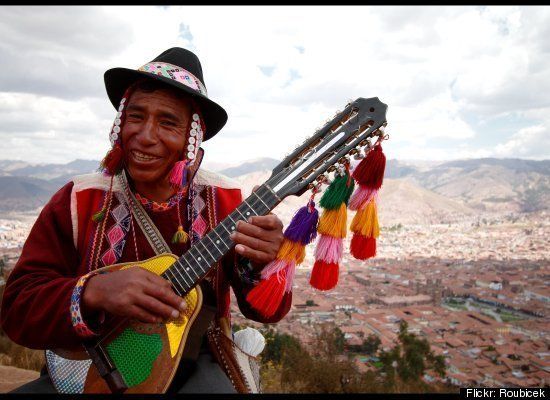
As we make our descent through the thick, night air, I peer out the window of our Boeing 757 and see nothing to indicate any life as I know it. No suburbs. No buildings. No city streets illuminated like a Lite-Brite board. Just pure, unyielding darkness. I feel a strange dichotomy, considering we're about to land in a place teaming with more life than anywhere on the planet. As I continue my stare into nothingness, a lone cottage lamp passes just beneath us and I realized how shockingly low we are. Seconds later, we touch down on a tiny airstrip carved out of the jungle. The engines roar into reverse thrust and the stewardess keys her microphone matter-of-factly, "Welcome to Iquitos, Peru."
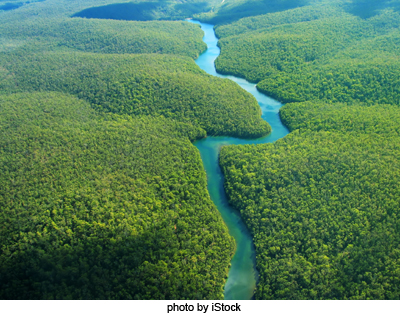
Stepping through the door onto the wheeled-up staircase, I feel as though I'm walking into a moist cloud, only warmer -- the air thick with humidity, abundant in oxygen. After gathering our bags and clearing customs, we are greeted by a young, enterprising sales force of street merchants, offering shoe shines, beads, silver earrings, bracelets -- anything for a buck, preferably American. Here, on this tight airstrip 4-degrees south of the equator, I listen to their relentless sales pitches, but hear something else entirely. It's a message that says, "Welcome to the third world."
After a morning's breakfast of Mango-Papaya puree, ham, croissants, pineapple and coffee with evaporated milk for cream, we are shuttled by van from our hotel to the Iquitos harbor, the city's only means of entry other than by air. Here, we board a small covered craft which will take us to our final destination -- the Yacumama Lodge, four hours up the Amazon, and that much further from even this tiny piece of civilization. The Amazon carries nearly 20 percent of the Earth's fresh water discharge to the ocean in a flow so powerful, it perceptibly dilutes the Atlantic up to 100 miles beyond the coastline.
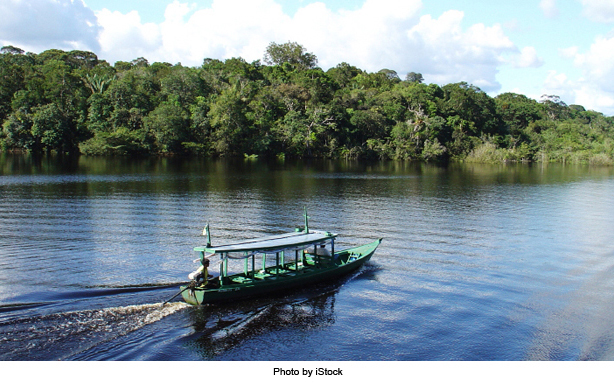
As we travel, I notice the flood line on the tree trunks is 10-15 feet above us -- a reminder of the vast cyclical changes this great river undergoes during the spring melts of the Andes. Low clouds of moisture lume across the sky. The shores are gradually getting denser as we leave Iquitos behind. I notice the occasional hut or small village built on stilts. Each hut is made from the jungle, with tree-limbed frames and palm thatched roofs. It takes my view of the Suburbs in a whole new direction.
Our arrival at the Yacumama lodge whelms me with a feeling of anticipation. Built and founded in 1992 by owner, Norman Walters, it is an oasis in the jungle. A beautiful wooden structure complete with main dining area, circular screened-in hammock room, two large shower areas, and covered walkways, carving through the jungle, interconnecting the intimate, private bungalows.

Although the main lodge area is solar powered, you'd never know it from an outside glance. Everything is built to blend in with the jungle. As we enter the main dining area, Norman introduces us to Estevan, a local Shaman and our guide through this vast expanse of knowledge. He holds out a tray filled with several glasses of a semi-sweet, semi-bitter Rum drink known as 7-root. It's made from Amazonian Rum and a combination of 7 local plants, which are boiled together for several days. 7-root is a sipping drink, and upon entering your blood, quickly finds its way into your soul.
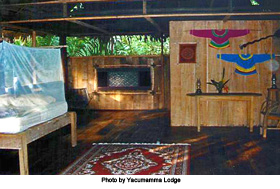 My cabin comes with all the Yacumama amenities -- no electricity, no TV and no room service. Just Hurricane lamps, a bed with Mosquito netting, table, chair and the hypnotic sounds of a world forgotten by time. It's November 1st, the beginning of the wet season and the rains have arrived. As night befalls, I hear the forest awaken. Hundreds of species of Frogs romance the air with their rhythmic mating calls. I also hear the bats that feed on them. They can tell by sound which Frogs will make delectable morsels and which ones will counter their bite with a lethal dose of poison. A bird lets out a prehistoric cry nearby and seconds later, the faint response from a mate erupts in the far distance. I feel like a spec of dust in this vastness. I drift off to the rhythm of the frogs and nocturnal Monkeys, leaping through the canopy, probably on their way to some local jungle boogie.
My cabin comes with all the Yacumama amenities -- no electricity, no TV and no room service. Just Hurricane lamps, a bed with Mosquito netting, table, chair and the hypnotic sounds of a world forgotten by time. It's November 1st, the beginning of the wet season and the rains have arrived. As night befalls, I hear the forest awaken. Hundreds of species of Frogs romance the air with their rhythmic mating calls. I also hear the bats that feed on them. They can tell by sound which Frogs will make delectable morsels and which ones will counter their bite with a lethal dose of poison. A bird lets out a prehistoric cry nearby and seconds later, the faint response from a mate erupts in the far distance. I feel like a spec of dust in this vastness. I drift off to the rhythm of the frogs and nocturnal Monkeys, leaping through the canopy, probably on their way to some local jungle boogie.
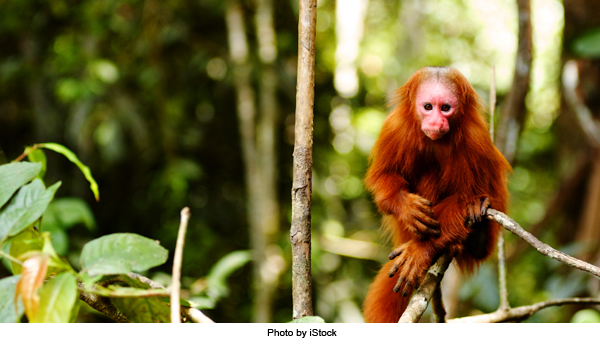
The breakfast horn, a shell our host Norman blows, sounds at 7:30, although I've been awake for nearly an hour. The rains have stopped, but large drops are still finding their way down from the flooded reservoirs of the upper canopy. The palm leaves surrounding my cabin are plush and thick, stemming 3-4 times my body length. As the droplets hit them, I notice the sound is 2 or 3 octaves below that of normal droplets. It wouldn't surprise me in the least to see a Tyrannosaurus during this trip.
As we prepare for our first nature hike. Estevan awaits, Machete in hand. I wear some Army fatigues, short sleeve shirt and a bush hat. Rubber boots are provided and protect against mud, moisture and the hundreds of life forms that want to get intimate with my feet. The first thing our Shaman points out is an Achiote tree -- what we call Paprika. It looks a lot like a Chestnut tree. Estevan takes one of the green, spiny balls extending down from the branches and cracks it open to reveal the tiny red ovals of Paprika. He takes a stick, pokes it inside and proceeds to paint my face with the red mixture. I feel like an Indian going off to battle. He then explains how the Paprika leaves, known as "15-leaf," cleanse the blood and are very good for the Kidneys. As we continue, we see a Jasmine tree, its sap is used to soothe an upset stomach. We pass some long-stemmed Lemon Grass, used for tea, candy and Mosquito repellent. It smells wonderful and I quickly rub it over my arms for added protection. I'm starting to feel like part of the jungle as Estevan directs our focus to the Uña De Gato or Cat's Claw. Here is a plant that looks pretty common, yet it can give you immense energy and is a powerful stimulant to the immune system. It's currently being used in Cancer research. I'm quickly ascertaining this place is the like the Garden of Eden; everything you need is provided. Suppose you develop Cataracts. Well, walk over to some Wild Ginger, pound the stem to extract the juice, put 2 drops a day into each eye and that's it. No laser surgery required. Or, if you need a weapon and you're in a hurry, you don't have to go to a Pawnshop. Just find yourself a Curare plant and coat the tips of your blowgun darts with its juice. The poison affects the nervous system and causes temporarily paralysis.
We progress through this magic kingdom, a cacophony of sounds dances around us. Estevan signals us to a nearby tree. There's a mud nest is structured around the trunk and the intersecting lower branches. He hacks a small portion off with his Machete and a swarm of tiny Termites erupts from within. Before I have time to react, he reaches in, letting the creatures crawl onto his fingers. I'm expecting some complex explanation about their healing qualities, but instead get a quick two-word synopsis as he puts his fingers into his mouth; "good protein," he says with a smile. I quickly follow suit, dipping my fingers into the nest and right back into my mouth. Most went down with one swallow, but the stragglers took a little more effort. They're crunchy and, believe it or not, taste a little like breath mints. I find myself wondering if this is what a jungle man would eat on his way to pick up a hot date.
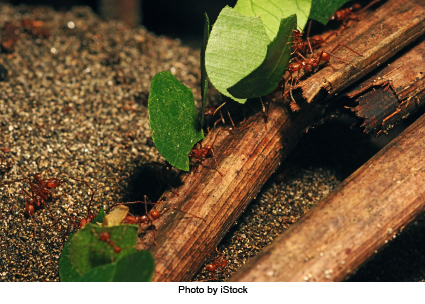 As we carve through the trail, we stumble upon a site I've only seen on the Discovery Channel and PBS. Leaf Cutter Ants. Thousands of them, marching single file from a nearby tree to their nest; a built-up dirt mount with a diameter up to 5 meters. The line has two lanes, with ants going toward the tree and ants returning, loaded with precision cut pieces of leaves three times the size of their bodies. I follow their path and see a section of tree that is now missing. Following their path leads our eyes to another site, a Heart of Palm tree with an outer root structure glowing bright red. These plants make great salads and Estevan says the Parakeets love them. On the medicinal side, their red roots make a tea that cures ulcers. Now it's time for lunch. And my guess is, it won't be Termites.
As we carve through the trail, we stumble upon a site I've only seen on the Discovery Channel and PBS. Leaf Cutter Ants. Thousands of them, marching single file from a nearby tree to their nest; a built-up dirt mount with a diameter up to 5 meters. The line has two lanes, with ants going toward the tree and ants returning, loaded with precision cut pieces of leaves three times the size of their bodies. I follow their path and see a section of tree that is now missing. Following their path leads our eyes to another site, a Heart of Palm tree with an outer root structure glowing bright red. These plants make great salads and Estevan says the Parakeets love them. On the medicinal side, their red roots make a tea that cures ulcers. Now it's time for lunch. And my guess is, it won't be Termites.
The food included with your lodging at Yacumama comes right out of the jungle. Fresh fish, either grilled, lightly fried or served Cuban style, rice, beans and a fresh salad or fruit with Plantains on the side. Every meal is served buffet-style with a variety of hot sauces you'll never see at your local deli. Healthy, different and extremely tasty, the food we eat embodies our surroundings. Fresh, natural and, look mom, no cholesterol. All the fruits and vegetables at Yacumama are specially washed or treated, so you don't have to worry about any after affects. Just enjoy.
After lunch, we are invited to go down river. And no outing is complete without rain parkas, hats and Estevan. There are many tributaries that stem from the Amazon. Ours is known as the Yarapa and we're heading to a place where it meets a similar flow of water, 15 minutes away. As we arrive, I notice the water here has less current and looks ideal for what we are about to do. We're going fishing. And the catch of the day is red-finned Piranha.
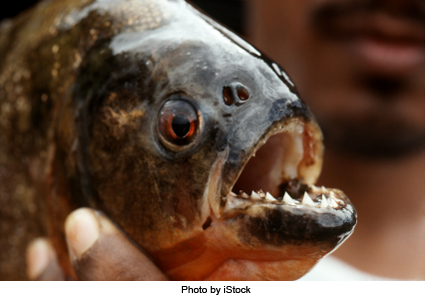 There are more than a dozen species of Piranha living in the waters of the Amazon Basin, the largest being the Pygocentrus Piraya, reaching lengths of 60 cm (24 in). The Piranha's normal diet consists of fruits, seeds and small fish, but all I've ever been told is that they attack and kill large animals. After mentioning this to Estevan, I'm told the truth of the matter. Yes, they occasionally devour large animals, but this is very rare, and avoidable if you know what to look for. The phenomenon only occurs during dry season when the river subsides. This remission cuts off some of the small ponds and lakes from their food supply. Competition becomes fierce and the Piranha become extremely agitated. They instinctively group together and will attack anything that enters the water. Knowing this makes me feel well rounded, but doesn't make me want to go swimming.
There are more than a dozen species of Piranha living in the waters of the Amazon Basin, the largest being the Pygocentrus Piraya, reaching lengths of 60 cm (24 in). The Piranha's normal diet consists of fruits, seeds and small fish, but all I've ever been told is that they attack and kill large animals. After mentioning this to Estevan, I'm told the truth of the matter. Yes, they occasionally devour large animals, but this is very rare, and avoidable if you know what to look for. The phenomenon only occurs during dry season when the river subsides. This remission cuts off some of the small ponds and lakes from their food supply. Competition becomes fierce and the Piranha become extremely agitated. They instinctively group together and will attack anything that enters the water. Knowing this makes me feel well rounded, but doesn't make me want to go swimming.
We agitate the water with the tips of our rods -- quite juxtaposed with Bass fishing, the tactics being to sneak up on the fish. No stealth operation here. There's food in the water. And we let them know it. I catch the first three Piranha, totaling 7 in just over an hour. You want to be extra careful taking the hook out of their mouths, for they instinctively bite down in rapid succession, as if sensing the proximity of your fingers. Their teeth strike me as being too big for their mouths. We brought home nearly 20 in all and, although Piranha wasn't on the diner menu, the lodge served our catch on the side as an extra bonus. I can't help feeling a little vengeful as I, a "large animal," eat a Piranha for a change.
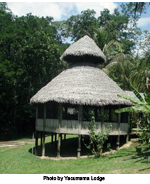 I now lay in a hammock, listening to the smatterings of rain outside the screened in windows. The ambiance and tropical smells here conjure so many new thoughts, especially for those who haven't stimulated their inputs for a while. I joke with my friends about the cadence of the Frogs. If recorded, it could become the latest "Soothing Nature Sounds" hit. We drink our Cervezas and feel our heartbeats begin to slow -- the perfect epitaph to a day in the jungle.
I now lay in a hammock, listening to the smatterings of rain outside the screened in windows. The ambiance and tropical smells here conjure so many new thoughts, especially for those who haven't stimulated their inputs for a while. I joke with my friends about the cadence of the Frogs. If recorded, it could become the latest "Soothing Nature Sounds" hit. We drink our Cervezas and feel our heartbeats begin to slow -- the perfect epitaph to a day in the jungle.
As I rock gently back and forth, I find an inner-self emerging that has lain dormant far too long. The boy, long suppressed by 50-hour workweeks and a society built around money and time. As a Baby Boomer, I came down here to learn about natural remedies and plants that heal. How was I to fathom the inner healing that has taken place just by spending a few days in this remote place. I have three more days to journey -- three more days to clear away the cobwebs from that person I used to know.
I will treasure every one.
Special thanks to Norman Walters, founder and owner of the Yacumama Lodge and to Steven and Darci with Salmon River Outfitters for providing such a special get away. Visit them on the web: yacumama.com or salmonriveroutfitters.com.